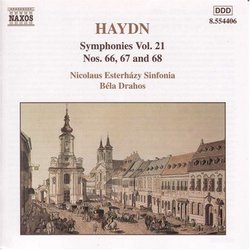Exploring the Haydn Symphonies -- Nos. 67,68,and 69
Robin Friedman | Washington, D.C. United States | 10/18/2004
(4 out of 5 stars)
"Joseph Haydn (1732-1809) began to compose symphonies in his late 20s and continued with the last of his "London" symphonies in 1794-1795. Throughout this period, his symphonies exhibit both continuity and a slow process of growth. It is an extraordinary listening experience to follow Haydn from his earliest symphonic efforts through his final symphonies which are masterworks of the classical form.
The symphonies on this CD form part of a complete collection of the 104 symphonies on Naxos. The series offers an opportunity to explore the creative genius of a composer who once observed that because there were no models available to him, he "was compelled to become original".
This disk,consisting of symphonies 66,67, and 68, features the Nicholaus Esterhazy Sinfonia conducted by Bela Drahos. These works were composed in the mid-1770s. I found it worthwhile in listening to these works to contrast them with Haydn's passionate "storm and stress" symphonies of the late 1760's and to compare them with some of Haydn's mid-50 symphonies (symphonies 54,56,57 on another Naxos CD) with which they share much in common. But each of these symphonies is a work of its own and worth hearing in its own right.
The symphony no.66 in B-flat major is the most conventional of this set. It has, in common with the mid-50's symphonies, a skipping opening allegro beginning with a loud chord together with much use of the solo bassoon. The first movement, allegro con brio, consists of contrasting themes following the loud opening chord. Most of this movement is carried by the strings. The second movement, adagio, is in three parts. It opens quietly in the strings and leads to an extensive passage for solo violin. The middle section moves into the minor key and builds to an intense climax before thr return of the opening material. The theme of the minuet is stated in the strings with solos for bassoon and oboe in the trio. The finale, appropriately labled "scherzando e presto" is a rapid and lightly moving rondo with much use of counterpoint and an episode in the minor key.
Symphonies nos. 67 and 68 are much more original compositions. The first movement of the symphony no. 67 in F major is marked presto and features a soft opening theme followed by a much more dramatic section for strings backed by the horn. The movement maintains a distinctive rhythmic swing throughout. The adagio is a contrasting movement consisting of a smooth, lyrical theme. It features solos near the end for two violins, a short passage to be played with the wood of the violin bow, and two solemn notes in the horn to end the movement. The minuet also includes marked solo passages for the violin in the top of its register contrasting with a droned accompaniment for a second soloist. (In this section, the G string on the violin needs to be tuned down one step.) The finale is an extended and unusual movement marked "allego di molto-adagio e cantabile-tempo primo". After the opening statment by the orchestra, the movement turns suddenly into an adagio featuring a string trio. The slow movement builds in intensity until joined by the entire ensemble before the return of the opening material. There are two better-known finales of this type (in which a slow section is interjected in the middle) in Mozart's E-flat major piano concertos K. 271 and K. 482. This is the first instance of which I am aware of the use of this pattern in a symphony.
The final work on this CD, the symphony no. 68 in B-flat major also is full of inventiveness. The opening vivace is lively and is highlighted by a quick run up the scale in the strings. The movement makes extensive use of the winds and includes solo writing for the bassoon and the violin in the development section. The minuet is placed second in this symphony. It is short and light with a legato theme framing the solo violin in the trio. The minuet sets the stage for the extensive adagio cantabile which is the centerpiece of this symphony. This movement is almost as lengthy as the remainder of the symphony. It features a flowing, lyrical theme in the opening and conclusion with a contrasting middle section. The movement proceeds at a good tempo, doesn't take itself overly seriously, and has a lovely swing. The finale, presto, is full of good humor with a lively theme, solos for the bassoon and other winds, and passages for various solo instruments entering in turn at the conclusion.
This is an excellent CD of some lesser-known Haydn symphonies.
"


 Track Listings (12) - Disc #1
Track Listings (12) - Disc #1